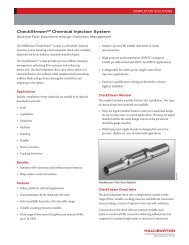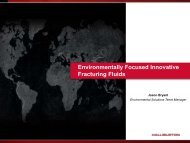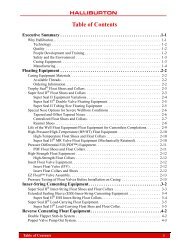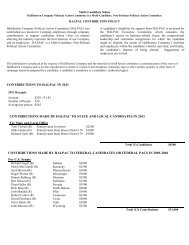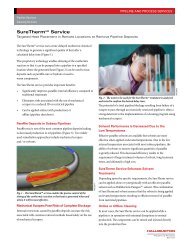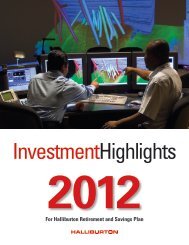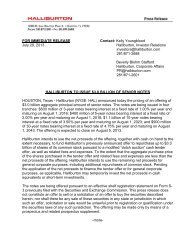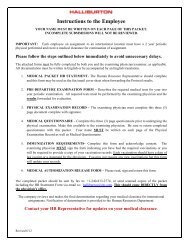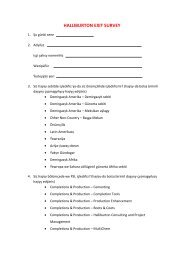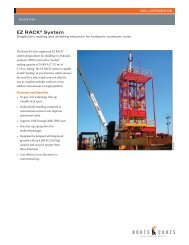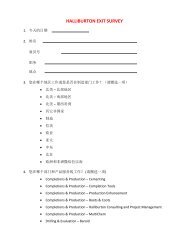HP/HT Client Brochure - Halliburton
HP/HT Client Brochure - Halliburton
HP/HT Client Brochure - Halliburton
Create successful ePaper yourself
Turn your PDF publications into a flip-book with our unique Google optimized e-Paper software.
HIGH PRESSURE/HIGH TEMPERATURE (<strong>HP</strong>/<strong>HT</strong>)<br />
Delivering success in <strong>HP</strong>/<strong>HT</strong> reservoirs<br />
through experience, innovation and reliable technologies<br />
Solving challenges.
HSE & Operational Excellence<br />
In the energy industry, companies must meet or exceed a<br />
vast array of environmental, health and safety standards.<br />
<strong>Halliburton</strong> goes beyond compliance to focus on sustainability<br />
in everything we do, striving to leave the places where we work<br />
better than we found them. Our goal is to provide products<br />
and services that have minimal environmental impact, are<br />
safe in their intended use, consume resources efficiently and<br />
can be recycled, re-used or disposed of safely. We have always<br />
embraced the job of ensuring that all our technologies meet the<br />
highest safety and environmental standards.<br />
Reliable equipment, people and processes are key to dealing<br />
with high temperature/high pressure situations<br />
High temperature and/or high pressure environments present<br />
significant dangers to people, property and the environment.<br />
High temperature situations can cause equipment failures<br />
that may lead to pressure issues and possible spills that could<br />
adversely affect the environment. In high pressure situations,<br />
the higher the pressure, the more stored energy is available.<br />
Should there be an uncontrolled release, it could cause serious<br />
injury to people and damage to property.<br />
Risk Management Solutions<br />
Boots & Coots, A <strong>Halliburton</strong> Service, offers Risk<br />
Management Solutions (RMS) that can help identify your<br />
<strong>HP</strong>/<strong>HT</strong> risks before they arise, reducing the potential for<br />
catastrophe and mitigate damages in the event a loss occurs.<br />
Our pre-event engineering services put Boots & Coots’<br />
unmatched experience with deep, high-pressure, high<br />
temperature wells—on land and offshore—into your<br />
organization in the early stages of a project. We provide<br />
customized prevention plans that may include training, risk<br />
analysis, contingency planning, audit programs, deepwater<br />
application and well inspections, as well as blowout prevention<br />
and control counsel or assistance in addressing identified<br />
risks. RMS saves time and money by reducing the frequency<br />
of critical well events and, when one does occur, getting<br />
production back on line as quickly as possible with as little<br />
damage as possible.<br />
<strong>Halliburton</strong>’s commitment to health, safety and the<br />
environment extends itself to high temperature/high pressure<br />
situations. Our reliable equipment, experienced people and<br />
best-in-class processes are key and essential to dealing with<br />
high temperature/high pressure environments.
As conventional sources of oil and gas decline,<br />
operators are increasingly turning their attention<br />
to unexplored or underdeveloped areas. High<br />
temperatures and/or high pressures are often found<br />
in these uncharted territories, presenting complex<br />
challenges including casing buckling, accelerated<br />
drilling fluid chemical reactions and rock collapse.<br />
<strong>Halliburton</strong> is well equipped to handle your <strong>HP</strong>/<strong>HT</strong> challenges<br />
<strong>Halliburton</strong> has more than 1,500 global <strong>HP</strong>/<strong>HT</strong> experts and<br />
the largest selection of <strong>HP</strong>/<strong>HT</strong> capabilities in the industry. Our<br />
experts approach <strong>HP</strong>/<strong>HT</strong> challenges by initially establishing<br />
a detailed understanding of your reservoir. After developing<br />
the most effective plan, we help operators execute, using the<br />
latest <strong>HP</strong>/<strong>HT</strong> evaluation, well construction, completions and<br />
stimulation technologies.<br />
<strong>Halliburton</strong> continually creates innovative <strong>HP</strong>/<strong>HT</strong><br />
technologies and processes that increase efficiency, recovery,<br />
safety and reliability in our specialized <strong>HP</strong>/<strong>HT</strong> research and<br />
development (R&D), testing and manufacturing facilities.<br />
These world-class facilities are equipped with the greatest<br />
number of test wells and cells in the service industry.<br />
Challenge spurs innovation that creates better tools<br />
and technologies<br />
From high pressure oil reservoirs in the deepwater to deep,<br />
hot, high pressure gas reservoirs, operators entrust <strong>Halliburton</strong><br />
with their toughest challenges.<br />
About <strong>HP</strong>/<strong>HT</strong><br />
According to the SPE E&P glossary, high temperature is where<br />
the undisturbed bottom hole temperature (at prospective reservoir<br />
depth or total depth) is greater than 300°F or 150°C. As for high<br />
pressure, that definition is met when the maximum anticipated<br />
pore pressure of the porous formation to be drilled exceeds a<br />
hydrostatic gradient of 0.8 psi/ft, or the well requiring pressure<br />
control equipment has a rated working pressure in excess of<br />
10,000 psi or 69 MPa.<br />
<strong>Halliburton</strong> has further defined <strong>HP</strong>/<strong>HT</strong> wells as follows:<br />
Borehole Temperature<br />
<strong>HT</strong> >300°F (150°C) - 350°F (175°C)<br />
Extreme <strong>HT</strong> >350°F (175°C) - 400°F (200°C)<br />
Ultra <strong>HT</strong> >400°F (200°C) and above<br />
Borehole Pressure<br />
<strong>HP</strong> >10,000 psi (69 MPa) - 15,000 psi (103 MPa)<br />
Extreme <strong>HP</strong> >15,000 psi (103 MPa) - 20,000 psi (138 MPa)<br />
Ultra <strong>HP</strong> >20,000 psi (138 MPa) and above<br />
As tools and technologies for these wells become conventional, the<br />
temperatures and pressures considered high, extreme or ultra will<br />
continue to rise.<br />
1 High Pressure/High Temperature
Challenges and Solutions<br />
Higher pressures and temperatures pose<br />
significant challenges—and opportunities<br />
Reservoirs with pressures and temperatures deemed higher than<br />
what was considered typical in the past are now frequent targets for<br />
exploration and development.<br />
However, temperature and pressure affect the physical strength,<br />
electronic function, sealing technology and chemical reaction of<br />
a technology or process. This imposes very real limitations on<br />
much of the technology currently available to help develop these<br />
reservoirs. <strong>Halliburton</strong> realizes the importance of investing in high<br />
pressure/high temperature (<strong>HP</strong>/<strong>HT</strong>) research, development (R&D)<br />
and new technology as a result of the industry undertaking the<br />
daunting challenge of commercializing deeply buried reservoirs.<br />
With more than 1,500 dedicated <strong>HP</strong>/<strong>HT</strong> experts around the world<br />
and the largest selection of <strong>HP</strong>/<strong>HT</strong> capabilities in the industry,<br />
<strong>Halliburton</strong>, continues to create innovative <strong>HP</strong>/<strong>HT</strong> technologies<br />
and processes that increase efficiency, recovery, safety and reliability.<br />
So how can high pressure and high temperature<br />
reservoirs be explored and developed successfully<br />
and cost effectively?<br />
<strong>Halliburton</strong> experts work with clients to better understand their<br />
reservoir and develop customized well plans specific to their asset.<br />
Through continuous collaboration, our specialists recommend<br />
solutions, not just specific technologies, to help the client get to<br />
production faster and safer.<br />
Our capabilities in <strong>HP</strong>/<strong>HT</strong> are the most extensive in the industry<br />
and one-of-a-kind due to our commitment to<br />
clients and our strong engineering, R&D and testing facilities. Our<br />
technologies have proven to be effective and reliable time over time<br />
making <strong>Halliburton</strong> the go-to provider for all of<br />
your <strong>HP</strong>/<strong>HT</strong> needs.<br />
High Pressure/High Temperature 2
3 High Pressure/High Temperature
<strong>Halliburton</strong> can meet your <strong>HP</strong>/<strong>HT</strong><br />
well construction challenges<br />
<strong>Halliburton</strong> <strong>HP</strong>/<strong>HT</strong> engineers designed our portfolio<br />
of well construction products to withstand heat, pressure<br />
and cyclical loading over the life of the well while providing<br />
maximum drainage for the reservoir. Our drilling fluids were<br />
developed to withstand temperatures up to 550°F/288°C with<br />
density values of up to 20 ppg without the use of weighting<br />
agents—thus minimizing the possibility of particle invasion.<br />
Operators can also reduce non-productive time (NPT) while<br />
delivering precise wellbore placement via <strong>Halliburton</strong>’s<br />
directional drilling tools. Using our Geo-Pilot® XL rotary<br />
steerable system that’s engineered to withstand temperatures<br />
up to 374°F/190°C and pressures up to 30,000 psi/207 MPa,<br />
these tools help clients achieve better hole quality and stay<br />
on target. For higher temperatures, <strong>Halliburton</strong> can provide<br />
turbines built to withstand temperatures up to 572°F/300°C.<br />
Our cementing service has been consistently ranked #1 in<br />
value by independent surveys of oil and gas customers and<br />
we offer cementing systems specifically designed for hightemperature<br />
wells, including cementing solutions tested and<br />
proven at temperatures as high as 750°F/399°C.<br />
<strong>Halliburton</strong> can meet your <strong>HP</strong>/<strong>HT</strong> formation<br />
and reservoir evaluation challenges<br />
To ensure equipment reliability, the highest quality data<br />
acquisition and a reduction of non-productive time during<br />
the formation and reservoir evaluation phase, <strong>Halliburton</strong><br />
developed a fleet of electronic components, systems and seals<br />
that can endure pressures greater than 35,000 psi/241 MPa,<br />
and temperatures up to 500°F/260°C—all while undergoing<br />
vibrations for extended periods of time.<br />
High Pressure/High Temperature 4
<strong>Halliburton</strong> can meet your <strong>HP</strong>/<strong>HT</strong> well<br />
completion and intervention challenges<br />
From years of experience and extensive collaboration<br />
with our clients, <strong>Halliburton</strong> has designed well completion<br />
tools that maximize production, despite the many<br />
environmental challenges <strong>HP</strong>/<strong>HT</strong> reservoirs pose. From casing<br />
inner diameter constraints to finding a seal compound that<br />
can withstand high pressures and/or temperatures or safety<br />
valves that can qualify for high pressures—<strong>Halliburton</strong> offers<br />
solutions that solve these and many more <strong>HP</strong>/<strong>HT</strong> challenges.<br />
Our well completion technologies are rated for temperatures<br />
up to 500°F/260°C and pressures up to 30,000 psi/207 MPa.<br />
<strong>Halliburton</strong> can meet your <strong>HP</strong>/<strong>HT</strong><br />
stimulation challenges<br />
With technologies that have no temperature and no pressure<br />
limitations, <strong>Halliburton</strong> provides cost-effective <strong>HP</strong>/<strong>HT</strong><br />
approaches to fracturing, pinpoint stimulation, acidizing/<br />
near-wellbore cleanout and conductivity endurance. Other<br />
stimulation solutions include fluids that resist stability<br />
breakdown in high temperatures. <strong>Halliburton</strong> also has the<br />
ability to deliver increased horsepower to handle the pressure<br />
in these challenging formations.<br />
As the global completions leader in swellable technology,<br />
surface and subsurface safety systems, high-pressure packer<br />
systems, intervention solutions, flow controls, service tools,<br />
expandable liner technology, engineering capability, testing<br />
facilities and manufacturing capacity, <strong>Halliburton</strong> focuses<br />
on increasing net present value by taking a systems approach<br />
to well completions for maximum recovery. In addition, our<br />
intelligent completion architectures, including SmartWell®<br />
intelligent completions and multilateral systems, enable<br />
efficient drainage of complex reservoirs. <strong>Halliburton</strong>’s full<br />
range of successful <strong>HP</strong>/<strong>HT</strong> completion technologies can have<br />
long-lasting benefits for the reservoir’s profitability.<br />
5 High Pressure/High Temperature
<strong>Halliburton</strong> Advantage<br />
Charting a course for a reliable future in high pressure<br />
high temperature wells since 1960<br />
<strong>Halliburton</strong> not only has the industry’s leading experts and the largest <strong>HP</strong>/<strong>HT</strong> fleet,<br />
we’ve been developing and upgrading our <strong>HP</strong>/<strong>HT</strong> capabilities for the last 50 years. From<br />
superior pressure management technologies to unique and industry leading advances in<br />
<strong>HT</strong> electronics, sealing technologies, <strong>HT</strong> elastomers and tailored operating practices that<br />
save time and reduce downtime, <strong>Halliburton</strong> is the one to call on to address the myriad of<br />
challenges an <strong>HP</strong>/<strong>HT</strong> well can present.<br />
Improving reliability through testing<br />
<strong>Halliburton</strong>’s primary service quality objective is to exceed our customer’s expectations. A<br />
key component of this process is our state-of-the-art testing and design validation facilities.<br />
Through the experience and knowledge of our people and a commitment to technological<br />
innovation, <strong>Halliburton</strong> continues to deliver safe, reliable and technically advanced<br />
products and services.<br />
High Pressure/High Temperature 6
<strong>HP</strong>/<strong>HT</strong> Testing and Design Validation Facilities<br />
Duncan Technology Center<br />
This award winning 230,000 sq ft (21,367 m2) facility is one<br />
of the largest facilities of its kind in the world. Testing under<br />
realistic conditions is offered by a 2,200 ft (671 m) test well<br />
and a deep-well simulator which can test at pressures up to<br />
20,000 psi/138 MPa and temperatures up to 475°F/246°C.<br />
The test well and deep-well simulator are located in a building<br />
adjacent to the rig, allowing many tool-development and<br />
procedural successes that have saved many months of<br />
development time.<br />
The facility is also equipped with a Pressure Testing and Tool<br />
Assembly unit with the capability to test mechanical burst and<br />
collapse pressures, the effects of elevated temperature on tool<br />
seals under operating conditions, and port seal crossing. The<br />
unit also constructs special pressure testing chambers.<br />
Carrollton Technology Center<br />
This center has developed a steady stream of innovative<br />
oil industry products with over 1,300 US Patents issued<br />
and numerous engineering innovation awards. A High-<br />
Temperature Facility and Deep Well Simulator Facility are<br />
included within the center and used to test experimental<br />
designs for <strong>HP</strong>/<strong>HT</strong> wells.<br />
The High-Temperature Test Facility has five below-ground<br />
heated test cells and one rapid cool down cell. Each test cell<br />
is designed to accommodate assemblies up to 30 ft (9 m) and<br />
30 in (762 mm) diameter and has a temperature range up to<br />
700°F/371°C. The device undergoing testing receives uniformly<br />
heated air to simulate severe temperatures downhole. The<br />
rapid cool down test cell employs a self-contained chiller unit<br />
capable of cooling to 32°F/0°C.<br />
A below-ground test facility, the Deep Well Simulator<br />
is designed to accommodate long assemblies up to 63 ft<br />
(19 m) with temperatures up to 1,000°F/538°C. Inside the<br />
cell, the device undergoing testing receives uniformly heated<br />
air, allowing a range of temperatures and pressures found in<br />
many severe wells to be simulated.<br />
7 High Pressure/High Temperature
North Belt Technology Center<br />
This facility includes an extensive Mechanical Test Laboratory<br />
and an <strong>HP</strong>/<strong>HT</strong> Vessel rated to 500°F/260°C, and 40,000<br />
psi/276 MPa. The High Temperature Flow Loop is rated to<br />
446°F/230°C and the Oven Farm currently has 20 chambers in<br />
service. To ensure operational reliability, <strong>Halliburton</strong> subjects<br />
all existing <strong>HP</strong>/<strong>HT</strong> tools to a specific temperature profile,<br />
which includes operational tests at 347°F/175°C and nonoperational<br />
soaking at 392°F/200°C.<br />
This facility will be home to “Project Victoria”, a project to<br />
create ultra <strong>HP</strong>/<strong>HT</strong> M/LWD tools for TOTAL’s Victoria<br />
field in the North Sea. Scheduled to begin in 2010, “Project<br />
Victoria” will require tools to be rated to 446°F/230°C and<br />
30,000 psi/207 MPa. First to be developed are directional<br />
probe, gamma ray sensor and pressure-while-drilling sensor.<br />
<strong>Halliburton</strong> is aiming at achieving tool survivability at<br />
482°F/250°C for the length of a 14-day bit run.<br />
Singapore Manufacturing and Technology Center<br />
Located in the Jurong industrial area in western Singapore, the<br />
20,252-square-meter (218,000 sq ft) facility is the Company’s<br />
second manufacturing facility in Singapore and is designed<br />
to support the growing demand for Sperry Drilling Services,<br />
<strong>Halliburton</strong> Wireline and Perforating Services and Security<br />
DBS Drill Bits tools worldwide.<br />
Jet Research Center (JRC)<br />
Located on more than 800 acres in Alvarado, Texas, JRC’s<br />
Explosive Products Center is a fully integrated research,<br />
engineering, testing and manufacturing plant that produces<br />
advanced perforating systems and specialty explosive devices for<br />
the oilfield, including shaped charge perforators, RF-protected<br />
detonators, tubing and casing cutters, severing tools and<br />
platform removal charges. JRC’s premier technical staff includes<br />
a balance of engineers, designers and technicians who are among<br />
the most knowledgeable experts in the perforating industry.<br />
Their backgrounds range from doctoral and Master’s level<br />
engineers to highly skilled explosive technicians-some with<br />
more than 25 years experience. Pressure Vessels and Thermal<br />
Ovens are available at the JRC to test explosive components<br />
and systems to conditions up to 30,000 psi/207 MPa and<br />
500°F/260°C. High-speed multichannel oscilloscopes,<br />
piezoelectric pins, ballistic pressure transducers and other<br />
specialty instrumentation are routinely used to conduct<br />
diagnostic experiments on explosive components and systems.<br />
The pioneering center produces sophisticated electronic<br />
sensors used in the Company’s signature logging-while-drilling<br />
tools and openhole wireline logging services, and it serves<br />
as a repair and maintenance facility for drilling tools used<br />
throughout the region.<br />
High Pressure/High Temperature 8
www.halliburton.com<br />
Sales of <strong>Halliburton</strong> products and services will be in accord solely with<br />
the terms and conditions contained in the contract between <strong>Halliburton</strong><br />
and the customer that is applicable to the sale.<br />
H07779<br />
01/11 © 2011 <strong>Halliburton</strong>. All Rights Reserved.
HIGH PRESSURE/HIGH TEMPERATURE (<strong>HP</strong>/<strong>HT</strong>)<br />
Sigma ® Process Using MRIL ® Measurement Technology Identifies Missed Zone,<br />
Adds Production Worth Over<br />
Location: Mexico<br />
Challenge<br />
In the Cuitlahuac field in Reynosa, PEMEX drilled a<br />
strategic well to prove the existence of new gas reserves,<br />
so drilling could be extended to include the west part of<br />
the field. Well conditions included 3,930 m depth,<br />
3½-in slim casing completion and 330°F (166°C) bottom<br />
hole static temperature.<br />
<strong>Halliburton</strong> Solution<br />
In order to establish new gas reserves, <strong>Halliburton</strong><br />
recommended using the Sigma® process incorporating<br />
NUMAR’s MRIL® measurement technology to estimate<br />
the delivery rates of the reservoirs. Conventional log<br />
interpretation showed hydrocarbons on entire sand zones<br />
and indicated a strong “shale” zone that the operator had<br />
been using as a shale barrier. The MRIL log showed effective<br />
porosity and important hydrocarbon volume only on<br />
intervals within the sand zones. Plus, the MRIL log<br />
showed the “shale” zone was in fact a sand zone and<br />
contained good grain size distribution and permeability.<br />
Based on Sigma analysis and MRIL interpretation,<br />
<strong>Halliburton</strong> and PEMEX fracturing experts selected the<br />
interval exhibiting the best perm and porosity. The interval<br />
selected included the former “shale” zone. After the interval<br />
was perforated, no appreciable pressure increase occurred<br />
and no radial flow.<br />
The usual procedure would have been to abandon the<br />
zone and fracture other intervals. However, using the<br />
Sigma process and studying drilling records showed that<br />
significant amounts of drilling fluid had been lost in the<br />
zone. <strong>Halliburton</strong> recommended an injectivity test before<br />
going to the upper intervals in order to remove the damage<br />
prior to fracturing.<br />
Economic Value Created<br />
<strong>Halliburton</strong>’s Thermagel fluid and Vicon NF breaker<br />
were used to place 20,000 lb of intermediate strength<br />
ceramic proppant. Results: After 10 days, gas production<br />
had settled out at 1.88 mmcfd and condensate production<br />
at 48 bpd. This production is worth over $1 million per<br />
year. In addition, PEMEX avoided fracturing another<br />
zone for an additional savings of $220,000.<br />
Note: Thermagel has been replaced by Sirocco,<br />
<strong>Halliburton</strong>’s next generation fracturing fluid system.<br />
www.halliburton.com<br />
Sales of <strong>Halliburton</strong> products and services will be in accord solely with the terms and conditions<br />
contained in the contract between <strong>Halliburton</strong> and the customer that is applicable to the sale.<br />
H07779 02/11 © 2011 <strong>Halliburton</strong>. All Rights Reserved.
HIGH PRESSURE/HIGH TEMPERATURE (<strong>HP</strong>/<strong>HT</strong>)<br />
Expedite ® Service Eliminates Proppant Flowback and<br />
Increases Gas Production by Approximately $1.8 Million<br />
Location: Mexico<br />
Challenge<br />
An operator needed to control proppant flowback after a<br />
fracturing treatment in a 16,269-feet high-pressure, hightemperature<br />
exploration well in a PP1 formation. The<br />
well’s bottomhole temperature was 397°F (202.8°C).<br />
<strong>Halliburton</strong> Solution<br />
<strong>Halliburton</strong> recommended using its Expedite® service to<br />
coat the proppant on the fly. The Expedite service provides<br />
a step-change improvement over conventional proppant<br />
flowback control systems and offers up to three times the<br />
conductivity of resin-coated proppants.<br />
Economic Value Created<br />
Following treatment, the well experienced no proppant<br />
flowback. The total economic value created was<br />
approximately $1.8 million based on a substantial<br />
increase in gas production.<br />
With Expedite ® service, capillary action causes flow of the liquid resin,<br />
concentrating it between proppant grains and resulting in greater<br />
concentration of resin at contact points for increased durability.<br />
Above are photomicrographs of a widely used resin.<br />
www.halliburton.com<br />
Sales of <strong>Halliburton</strong> products and services will be in accord solely with the terms and conditions<br />
contained in the contract between <strong>Halliburton</strong> and the customer that is applicable to the sale.<br />
H07779 02/11 © 2011 <strong>Halliburton</strong>. All Rights Reserved.
HIGH PRESSURE/HIGH TEMPERATURE (<strong>HP</strong>/<strong>HT</strong>)<br />
Rigorous QA/QC Procedure Enables Successful Perforating of <strong>HT</strong> Wells<br />
Location: East Lost Hills Project, California<br />
Challenge<br />
An operator required a tubing-conveyed perforating<br />
(TCP) system for a four-well project after a previous<br />
system failed due to elastomer leakage in the firing head.<br />
The successful TCP system had to be capable of handling<br />
bottomhole temperatures as high as 425°F (218°C) for up<br />
to 200 hours before the perforating guns would be fired.<br />
<strong>Halliburton</strong> Solution<br />
<strong>Halliburton</strong>’s TCP system was successfully used<br />
without any modifications. Due to the critical nature of<br />
perforating operations in high-pressure/high-temperature<br />
completions, <strong>Halliburton</strong> performed rigorous quality<br />
assurance/quality control (QA/QC) testing on all<br />
components before deployment.<br />
Economic Value Created<br />
<strong>Halliburton</strong>’s QA/QC process resulted in the allocation of<br />
a quality-controlled TCP inventory that was successfully<br />
used on all four wells in the project without lost time.<br />
This procedure was also used to establish a contingency<br />
thru-tubing perforating inventory required for some of the<br />
project’s completions.<br />
www.halliburton.com<br />
Sales of <strong>Halliburton</strong> products and services will be in accord solely with the terms and conditions<br />
contained in the contract between <strong>Halliburton</strong> and the customer that is applicable to the sale.<br />
H07779 02/11 © 2011 <strong>Halliburton</strong>. All Rights Reserved.
HIGH PRESSURE/HIGH TEMPERATURE (<strong>HP</strong>/<strong>HT</strong>)<br />
GeoTap ® Formation Pressure Tester Saves Operator US $3-6 Million<br />
Location: Deepwater Gulf of Mexico<br />
Challenge<br />
An operator was drilling a subsalt deepwater [water<br />
depth of 4,986 feet (1,520 m)] well in the Gulf of Mexico<br />
and required real-time pore pressure measurements of<br />
the formation to help optimize mud weight and manage<br />
equivalent circulating density. Miocene formations in<br />
the Gulf of Mexico are characterized by narrow pore<br />
pressure/fracture gradient margins which can result in<br />
ballooning events when the mud weight reaches the<br />
fracture pressure of the formations. In this environment,<br />
predicting pore pressure with resistivity sensors is difficult<br />
because of the well’s close proximity to salt formations.<br />
Uplifted formations can result in the pore pressure in<br />
the sand formations being higher than the shale pore<br />
pressures due to buoyancy effects. A combination of these<br />
challenges prompted the operator to run a real-time pore<br />
pressure measurement tool.<br />
<strong>Halliburton</strong> Solution<br />
<strong>Halliburton</strong> drilling services recommended the GeoTap®<br />
formation pressure tester for real-time formation pressure<br />
measurements. The drilling team utilized the 9-1/2-in.<br />
and 8-in. GeoTap formation pressure testers to measure<br />
the actual formation pressure as the team drilled to<br />
help optimize mud weight. The GeoTap tester provided<br />
real-time formation pressure measurements, delivering<br />
early and reliable results. This aided in determining and<br />
maintaining optimal mud weight, reduced formation<br />
damage and increased rate of penetration.<br />
Economic Value Created<br />
The operator saved approximately $3 million when<br />
information provided by the GeoTap testers made<br />
it possible to eliminate a planned expandable casing<br />
string, and saved an additional estimated $3 million<br />
by eliminating the need for a contingent casing string.<br />
Based on this success, the GeoTap tester is now part of<br />
the standard bottomhole assembly on subsalt deepwater<br />
exploration wells for this operator.<br />
In addition to saving the operator a substantial amount<br />
of money, the 8-in. GeoTap formation pressure tester<br />
demonstrated record performance in this well. It<br />
achieved the deepest-ever high-quality test, taken at<br />
29,898 feet (9,113 m) measured depth, 28,525 feet<br />
(8,694 m) true vertical depth. The tool also acquired<br />
two of the highest measured pressures to date, with a<br />
hydrostatic pressure measurement of 22,538 psi (155<br />
MPa) and formation pressure of 22,008 psi (152 MPa).<br />
www.halliburton.com<br />
Sales of <strong>Halliburton</strong> products and services will be in accord solely with the terms and conditions<br />
contained in the contract between <strong>Halliburton</strong> and the customer that is applicable to the sale.<br />
H07779 02/11 © 2011 <strong>Halliburton</strong>. All Rights Reserved.
HIGH PRESSURE/HIGH TEMPERATURE (<strong>HP</strong>/<strong>HT</strong>)<br />
Weighted Fracturing Stimulation Fluid Reduced Surface Treating Pressures,<br />
Allowing Record-Setting Well Test in Deepwater GOM Project<br />
Location: Deepwater Gulf of Mexico<br />
Challenge<br />
Chevron’s Jack #2 well at Walker Ridge Block 758 in<br />
the Gulf of Mexico (GOM) Lower Tertiary trend is in<br />
7,000 feet (2,134 m) of water, with a reservoir target greater<br />
than 20,000 feet (6,096 m) below mudline. Because of the<br />
high fracture gradient and friction in the wellbore tubulars,<br />
the surface treating pressure generated by a conventional<br />
fracturing fluid system was expected to exceed the<br />
15,000 psi (103 MPa) surface equipment safety limitations.<br />
Chevron was confronted with finding a proven, weighted<br />
fracturing stimulation fluid that could meet the challenges<br />
of this deepwater environment.<br />
<strong>Halliburton</strong> Solution<br />
<strong>Halliburton</strong> designed the DeepQuest® treatment fluid that<br />
would work within the safe pressure parameters, which was<br />
pioneered on the deepwater GOM Tahiti prospect in 2004.<br />
The fluid helps ensure that surface treating pressures stay<br />
within the operating limits of the flexible treating line from<br />
the marine vessel and the surface treating lines on the rig<br />
floor at the required pump rates. In combination with the<br />
proven deepwater FracPac tool system, the fluid made<br />
it possible to enhance the productivity of the ultra-deep<br />
Jack #2 well using fracturing stimulation.<br />
Economic Value Created<br />
The well test and fracpack were successful, exceeding<br />
Chevon’s expectations. Surface treating pressures with<br />
the DeepQuest weighted fluid were substantially reduced,<br />
which allowed the operator to successfully perform the<br />
treatment in the challenging deepwater GOM environment.<br />
Without fracturing, the economic viability of projects like<br />
the Jack #2 well would be significantly challenged. The<br />
ability of <strong>Halliburton</strong>’s stimulation fluid service to reduce<br />
surface treating pressure allowed the operator to safely<br />
complete the frac within the surface equipment limits,<br />
and reduced Chevron’s need and cost for obtaining<br />
higher-pressure equipment. Chevron successfully drilled<br />
the Jack #2 well to a total depth of 28,175 feet (8,588 m)<br />
and completed a record-setting well test with a sustained<br />
flow rate of more than 6,000 bbl/day.<br />
www.halliburton.com<br />
Sales of <strong>Halliburton</strong> products and services will be in accord solely with the terms and conditions<br />
contained in the contract between <strong>Halliburton</strong> and the customer that is applicable to the sale.<br />
H07779 02/11 © 2011 <strong>Halliburton</strong>. All Rights Reserved.
HIGH PRESSURE/HIGH TEMPERATURE (<strong>HP</strong>/<strong>HT</strong>)<br />
Diesel-Based Fluid Successful in Deep, High-Pressure Wells<br />
with Hard Formations Project<br />
Location: West Texas<br />
Challenge<br />
Maximum mud weights in the 17.2 ppg range and hard<br />
Pennsylvanian era formations in a West Texas field made<br />
drilling slow and challenging. The highly pressured<br />
Atoka formation and lower pressured zones including the<br />
Strawn and Morrow were drilled within the same interval.<br />
Mud weight was critical and equivalent circulating<br />
density (ECD) control was a primary concern. Tripping<br />
operations required spotting pills and staging in and out<br />
of the hole.<br />
<strong>Halliburton</strong> Solution<br />
<strong>Halliburton</strong> personnel recommended drilling with the<br />
clay-free, diesel-based INTEGRADE® system because of<br />
its ability to help maintain a stable wellbore. Drilling with<br />
INTEGRADE fluid can also help increase penetration<br />
rates and optimize ECD control.<br />
Cuttings Loading<br />
Economic Value Created<br />
The operator agreed to try the INTEGRADE system and<br />
the well was displaced with a 16.4 ppg INTEGRADE<br />
fluid at 12,753 feet (3,887 m) after drilling out from<br />
intermediate casing. The production interval was drilled<br />
to 17,650 feet (5,380 m). There were no unforeseen events<br />
and casing was set with no problem.<br />
ROP<br />
1000<br />
2000<br />
3000<br />
4000<br />
5000<br />
6000<br />
7000<br />
8000<br />
9000<br />
10000<br />
11000<br />
12000<br />
13000<br />
14000<br />
15000<br />
16000<br />
17000<br />
18000<br />
Operator Aramco Well: Location: Gulf Prepared by: Baroid DFG Center<br />
Accolade<br />
Well #1<br />
Rig: Iron 55<br />
Flow Rate = 200 gal/min<br />
Cuttings Load %<br />
Transport<br />
Average V. ft/min Hole Angle ECD lb/gal<br />
Mud Weight = 16.3 lb/gal<br />
Eff avg %<br />
R-1 s@ 60 ft/hr-80 rpm<br />
2.75<br />
w/o Cut<br />
19.75 in<br />
2.44<br />
w/ Cut<br />
925.0 (925.0) ft<br />
16.336/16.485 lb/gal<br />
12.375 in<br />
2.34<br />
3952.0 (3952.0) ft<br />
16.391/16.527 lb/gal<br />
2.18<br />
10.711 in<br />
5500.0 (5500.0) ft<br />
16.415/16.548 lb/gal<br />
8.575 in<br />
11221.0 (11221.0) ft<br />
16.614/16.739 lb/gal<br />
2.06<br />
8.5 in<br />
2.63<br />
12516.0 (12514.0) ft<br />
16.637/16.761 lb/gal<br />
9.5 in<br />
2.54<br />
17660.0 (17315.0) ft<br />
2.37<br />
16.635/16.763 lb/gal<br />
18110.0<br />
5 10 15 20 25 0 50 100 0 52 104 30 60 90 16.30 16.80 17.30<br />
ECD<br />
2.471% Cutting Total<br />
ROP = 60 ft/hr<br />
2.337% Cutting Eff<br />
Cutting Dia. = 0.35 in<br />
5 x 4.276 x 16617.6 ft<br />
5 x 3 x 600 ft<br />
6.25 x 2.75 x 442.4 ft<br />
www.halliburton.com<br />
Sales of <strong>Halliburton</strong> products and services will be in accord solely with the terms and conditions<br />
contained in the contract between <strong>Halliburton</strong> and the customer that is applicable to the sale.<br />
H07779 02/11 © 2011 <strong>Halliburton</strong>. All Rights Reserved.
HIGH PRESSURE/HIGH TEMPERATURE (<strong>HP</strong>/<strong>HT</strong>)<br />
Controlling Well Direction While Opening Hole in<br />
<strong>HP</strong>/<strong>HT</strong> Deepwater Vertical Well Saves Customer Millions<br />
Location: Mediterranean<br />
Challenge<br />
A vertical well needed to be drilled in the deepwater,<br />
high pressure high temperature (<strong>HP</strong>/<strong>HT</strong>) environment<br />
of the Mediterranean Sea, where maximum temperature<br />
and pressure were approximately 390°F (199°C) and<br />
20,000 psi (138 MPa). Several casing strings would be<br />
required and hole opening would be needed for the<br />
majority of hole sections. Also, hole verticality, especially<br />
in the upper section, was considered crucial to minimize<br />
the potential dangers of excessive torque and drag.<br />
<strong>Halliburton</strong> Solution<br />
The Geo-Pilot® system was run in the vertical drilling<br />
mode in tandem with the under reamer for several<br />
different intervals. The Geo-Pilot system with Geo-Span®<br />
downlink service was mobilized where historically in<br />
offset wells, formations had naturally built angle. At<br />
the final total depth of approximately 22,000 feet<br />
(6,700 m), the offset from the wellhead was below<br />
110 ft (33.5 m), giving an average inclination from<br />
the surface to bottomhole location of only 0.3°.<br />
Economic Value Created<br />
Being able to control well direction and open the hole<br />
at the same time saved the customer an estimated<br />
US $1.8 million to US $4.5 million, depending on<br />
what other method of drilling could have been used.<br />
www.halliburton.com<br />
Sales of <strong>Halliburton</strong> products and services will be in accord solely with the terms and conditions<br />
contained in the contract between <strong>Halliburton</strong> and the customer that is applicable to the sale.<br />
H07779 02/11 © 2011 <strong>Halliburton</strong>. All Rights Reserved.
HIGH PRESSURE/HIGH TEMPERATURE (<strong>HP</strong>/<strong>HT</strong>)<br />
DeepQuest SM<br />
<strong>HT</strong> Stimulation Service Helps Unlock Hot, Tight Gas Reservoir<br />
Location: Saudi Arabia<br />
Challenge<br />
Saudi Aramco faced an extreme high pressure high<br />
temperature (<strong>HP</strong>/<strong>HT</strong>) stimulation challenge in a new<br />
field, with a 375°F (191°C) reservoir temperature and<br />
more than 15,000 psi (103 MPa) required for fracturing.<br />
Developing an innovative way to frac under these <strong>HP</strong>/<strong>HT</strong><br />
tight gas sandstone conditions was crucial to Saudi Aramco<br />
for stimulating and proving the reserves of the tight gas<br />
formations in northwestern Saudi Arabia.<br />
<strong>Halliburton</strong> Solution<br />
The <strong>Halliburton</strong> Saudi Arabia Production Enhancement<br />
team worked with experts in Duncan, Oklahoma and<br />
Houston, Texas to develop the DeepQuest <strong>HT</strong> fluid<br />
system to perform under these extreme conditions.<br />
Economic Value Created<br />
The Saudi Aramco job was performed flawlessly by pumping<br />
16.4 barrels per minute at 21,000-psi bottomhole treating<br />
pressure. As specified in the design, <strong>Halliburton</strong>’s Production<br />
Enhancement team pumped 80,000 gallons of the gel system<br />
and placed more than 150,000 pounds of proppant.<br />
Wellhead Pressure (psi)<br />
Comparison of Wellhead Pressure of a Conventional<br />
Crosslinked Fluid vs. DeepQuest <strong>HT</strong> Fluid<br />
16000<br />
15000<br />
14000<br />
13000<br />
12000<br />
11000<br />
10000<br />
9000<br />
10 15 20 25 30<br />
6% KCI Crosslinked Fluid<br />
DeepQuest <strong>HT</strong> Fluid - 12.3 lb/gal<br />
www.halliburton.com<br />
Sales of <strong>Halliburton</strong> products and services will be in accord solely with the terms and conditions<br />
contained in the contract between <strong>Halliburton</strong> and the customer that is applicable to the sale.<br />
H07779 02/11 © 2011 <strong>Halliburton</strong>. All Rights Reserved.
HIGH PRESSURE/HIGH TEMPERATURE (<strong>HP</strong>/<strong>HT</strong>)<br />
Fracturing Solution Enables Improved Production<br />
Location: Southeastern USA<br />
Challenge<br />
An operator planning an 11,500 ft (3,505 m) total vertical<br />
depth Haynesville shale formation well with a 4,000 ft<br />
(1,219 m) horizontal section was looking for a fracturing<br />
solution to maximize production in an area where results<br />
are often disappointing. Because the area is at the outer<br />
limits of the Haynesville shale play, initial production<br />
typically runs just 3 to 4 million standard cubic feet per day<br />
(MMscf/d). Compounding the difficulties, the formation<br />
is tight and clay rich, making it difficult to place proppant.<br />
Bottomhole static temperature was 315°F (157°C).<br />
<strong>Halliburton</strong> Solution<br />
<strong>Halliburton</strong> recommended treated water, and the<br />
WaterFrac G and Hybor G fracturing fluid systems for<br />
the multi-stage treatment. Six percent NaCl was used for<br />
the base fluid with ViCon NF breaker, GasPerm 1000<br />
additive, SandWedge® conductivity enhancement system,<br />
and 30/50 and 30/60 premium proppant.<br />
Estimated Value Created<br />
The frac job proceeded as planned, enabling the well to<br />
produce 7 MMscf/d, which is the second highest initial<br />
production ever recorded in this area. The total estimated<br />
value created is approximately $6.5 million per year based<br />
on a gas price of $4.60/Mscf at a sustained production rate<br />
of 5 MMscf/d.<br />
www.halliburton.com<br />
Sales of <strong>Halliburton</strong> products and services will be in accord solely with the terms and conditions<br />
contained in the contract between <strong>Halliburton</strong> and the customer that is applicable to the sale.<br />
H07779 02/11 © 2011 <strong>Halliburton</strong>. All Rights Reserved.





